Section 1: Agency overview and resources
1.1 Strategic direction
The Royal Australian Mint (the Mint) was officially opened in 1965 and is a prescribed agency operating under the Financial Management and Accountability Act 1997. The Mint's vision is to achieve excellence as a profitable world class mint. It strives to meet the circulating coin and collector coin needs of Australia and selected international markets. The Mint is also the custodian of the Australia's National Coin Collection and provides educational and tourist services to local and overseas residents.
The Mint will continue to optimise productivity returns and refine its capabilities and capacities. In the year ahead, the Mint will be targeting and converting revenue growth opportunities; building on its positive brand recognition; ensuring staff and visitors have a safe and secure environment in which to work and visit; and engaging its staff to further develop their skills, motivation and commitment.
Given the nature of its operations, the Mint will maintain vigilance in securing a safe and secure environment. The Mint's priority for 2011-12 is to develop and motivate its staff so they are equipped to deal with the new challenges and opportunities facing the Mint as it embarks on its growth strategy.
The Mint will assist in the development and implementation of a new national circulating coin supply chain model. The Mint will play a central role in managing the movement of coins in circulation by centralising and managing key information that will better align coin supply and demand. This will create more timely and reliable coin forecasting data and will improve efficiencies in coin circulation and coin supply management.
In September 2010, the Mint hosted the XXVI Mint Directors Conference. A key outcome from the conference was the opportunity to identify and develop overseas markets for its expertise. Several successful sales have already been achieved and the Mint intends to build on this early success with a targeted international business development program.
1.2 Agency resource statement
Table 1.1 shows the total resources from all sources. The table summarises how resources will be applied by outcome and by administered and departmental classification.
Table 1.1: Royal Australian Mint resource statement — Budget estimates
for 2011-12 as at Budget May 2011
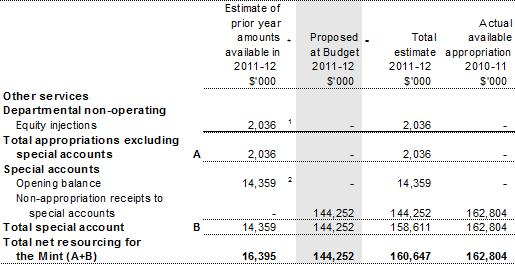
1. Estimated adjusted balance carried from prior years for annual appropriation.
2. Estimated opening balance for special accounts (refer to Table 3.1.2 for further details).
1.3 Budget measures
The Mint does not have any Budget measures for 2011-12.
Section 2: Outcomes and planned performance
2.1 Outcomes and performance information
Government outcomes are the intended results, impacts or consequences of actions by the Government on the Australian community. Commonwealth programs are the primary vehicle by which government agencies achieve the intended results of their outcome statements. Agencies are required to identify the programs which contribute to Government outcomes over the budget and forward years.
The Mint's outcome is described below, specifying the strategy, program, objective, deliverables and key performance indicators used to assess and monitor the performance of the Mint.
Outcome 1: The coinage needs of the Australian economy, collectors and foreign countries are met through the manufacture and sale of circulating coins, collector coins and other minted-like products
Outcome 1 strategy
To achieve this outcome the Mint will continue to:
- produce cost efficient circulating coins for Australia;
- produce appropriate circulating coins for foreign jurisdictions under commercial arrangements;
- maintain an Australian circulating coin buffer stock;
- provide advice to the Treasury and government on coin related issues; and
- develop and produce high quality profitable numismatic products.
As the sole producer of Australian circulating coin and custodian of the National Coin Collection, the following activities are an adjunct to the key strategies outlined above:
- delivering an education program through the Mint's visitors centre;
- promoting public understanding of the cultural and historical significance of coins; and
- maintaining Australia's National Coin Collection.
Outcome expense statement
Table 2.1 provides an overview of the total expenses for Outcome 1.
Table 2.1: Budgeted expenses and resources for Outcome 1
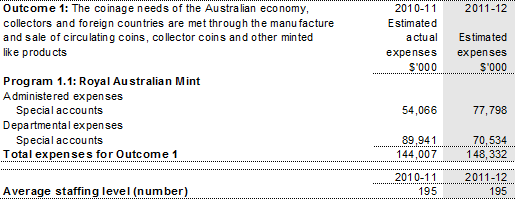
Contributions to Outcome 1
Program 1.1: Royal Australian Mint
Program objective
To produce and distribute circulating coins, collector coins and minted-like products to meet the demands of the Australian economy, collectors and foreign countries.
Program expenses
The costs of production, warehousing and distribution of minted circulating coins are dependent on the demand for circulating coin by the Reserve Bank of Australia and Australian commercial banks.
Table 2.2 Program expenses
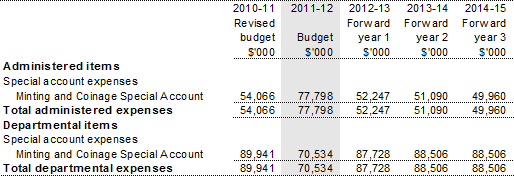
Program deliverables
The Mint has the following deliverables:
- produce Australian circulating coins to meet the demands of the Australian community;
- maintain minted Australian circulating coin inventory within agreed buffer stock parameters;
- produce circulating coins to meet demand from foreign countries;
- produce numismatic products to meet Australian and overseas demand;
- maintain Australia's National Coin Collection;
- maintain the Mint's visitor gallery, including building and surrounds;
- provide an educational program to school students who visit the Mint; and
- promote public understanding about the cultural and historical significance of coins.
Program key performance indicators
The Mint has the following key performance indicators:
- produce and deliver Australian circulating coins in a cost effective and timely manner;
- foreign circulating coin sales meet or exceed cost of production;
- at least 95 per cent of numismatic orders placed are produced and delivered within contracted delivery time;
- all numismatic sales meet or exceed cost of production;
- rotate the display of Australia's National Coin Collection on a regular basis;
- maintenance of gallery and visitor centre to community standard;
- ensure that school student visitor programs align with relevant school curricula; and
- increase in visitor numbers to the gallery and visitor centre compared to prior year's actual visitor numbers.
Section 3: Explanatory tables and budgeted financial statements
Section 3 presents explanatory tables and budgeted financial statements which provide a comprehensive snapshot of agency finances for the 2011-12 budget year. It explains how budget plans are incorporated into the financial statements and provides further details of the reconciliation between appropriations and program expenses, movements in administered funds, special accounts and government Indigenous expenditure.
3.1 Explanatory tables
3.1.1 Movement of administered funds between years
The Mint does not have any movement of administered funds.
3.1.2 Special accounts
Special accoun
ts provide a means to set aside and record amounts used for specified purposes. Special accounts can be created by a Finance Minister's Determination under the Financial Management and Accountability Act 1997 or under separate enabling legislation. Table 3.1.2 shows the expected additions (receipts) and reductions (payments) for each account used by the Mint.
Table 3.1.2: Estimates of special account cash flows and balances

3.1.3 Australian Government Indigenous Expenditure
The Mint does not have any Australian Government Indigenous Expenditure.
3.2 Budgeted financial statements
3.2.1 Differences in agency resourcing and financial statements
The Mint does not have any significant differences between the resource information presented in the Budget Papers and the Portfolio Budget Statements as a result of differences between whole of government level financial reporting (under Australian Accounting Standard 1049) and entity level financial reporting.
3.2.2 Analysis of budgeted financial statements
There is an increase in the operating surplus in 2011-12 compared to 2010-11 due to a greater decrease in supplier costs compared to expected revenue.
There is an increase in the estimated cash balances in the Mint's budgeted departmental statement of cash flows. This movement is due to the decrease in supplier expenses.
3.2.3 Budgeted financial statements tables
Table 3.2.1: Budgeted departmental comprehensive income statement
(for the period ended 30 June)
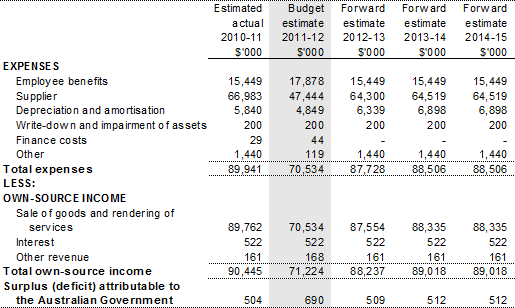
Prepared on Australian Accounting Standards basis.
Table 3.2.2: Budgeted departmental balance sheet
(as at 30 June)
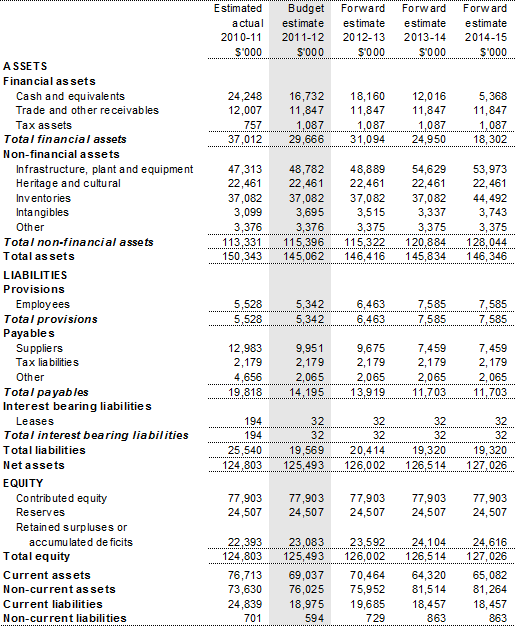
Prepared on Australian Accounting Standards basis.
Table 3.2.3: Budgeted departmental statement of cash flows
(for the period ended 30 June)
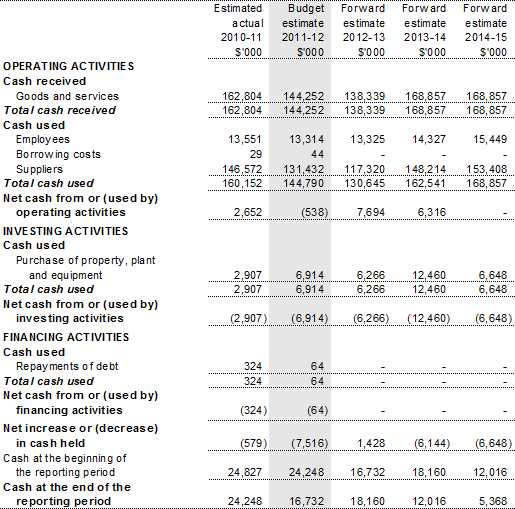
Prepared on Australian Accounting Standards basis.
Table 3.2.4: Departmental statement of changes in equity — summary of
movement (budget year 2011-12)
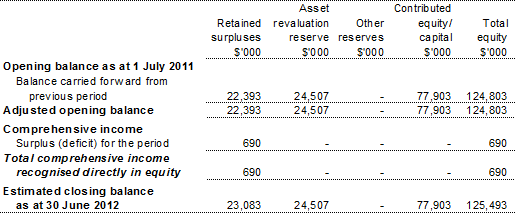
Prepared on Australian Accounting Standards basis.
Table 3.2.5: Departmental capital budget statement
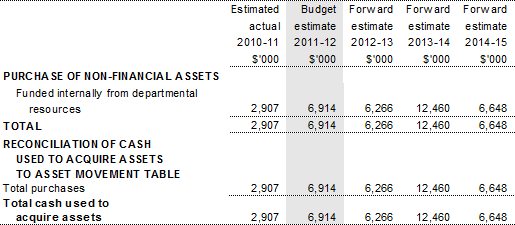
Prepared on Australian Accounting Standards basis.
Table 3.2.6: Statement of asset movements — departmental
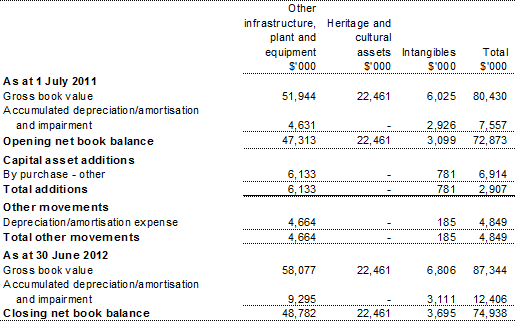
Prepared on Australian Accounting Standards basis.
Table 3.2.7: Schedule of budgeted income and expenses administered on behalf of
government (for the period ended 30 June)
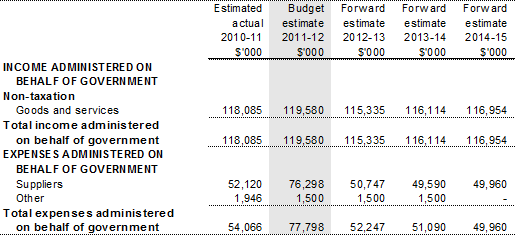
Prepared on Australian Accounting Standards basis.
Table 3.2.8: Schedule of budgeted assets and liabilities administered on behalf of
government (as at 30 June)
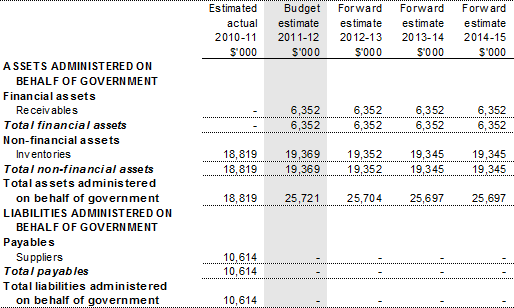
Prepared on Australian Accounting Standards basis.
Table 3.2.9: Schedule of budgeted administered cash flows
(for the period ended 30 June)
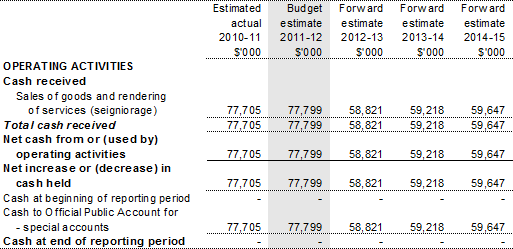
Prepared on Australian Accounting Standards basis.
Table 3.2.10: Schedule of administered capital budget
The Mint has no administered capital budget.
Table 3.2.11: Schedule of asset movements — administered
The Mint has no administered asset movements.
3.2.4 Notes to the financial statements
Departmental
Basis of accounting
The Mint's budgeted statements have been prepared on an accrual basis, in accordance with the historical cost convention except for some assets and liabilities that are at valuation and in accordance with:
- the Australian Government's financial budgeting and reporting framework; and
- Australian Accounting Standards.
Budgeted departmental income statement
Revenues
Revenue is derived from the production of circulating coins, the sale of numismatic coins and coin like products. The amount of revenue earned in any one year is dependent upon the demand for such products by the Australian financial institutions and the coin collecting market.
Expenses
Employees
This includes wages and salaries, superannuation, provision for annual leave and long service leave.
Depreciation and amortisation
Depreciable assets are written off over their estimated useful lives, using the straight-line method.
Other
Other expenses include the cost of goods sold.
Budgeted departmental balance sheet
Non-financial assets
Inventory
Inventories held for resale are at the lower of cost and net realisable value. Work in progress and finished goods are brought to account to include direct costs and a portion of direct labour and overhead. All precious metals are purchased and brought to account at cost.
Provisions and payables
Employees
The liability for employee entitlements includes provision for annual leave and long service leave. No provision has been made for sick leave, as all sick leave is non-vesting.
The non-current portion of the liability for long service leave is recognised and measured at the present value of the estimated future cash flows in respect of all employees.
Asset valuation
Commonwealth Government agencies are required to value property, plant and equipment and other infrastructure assets using the fair value method of valuation.
Administered
Seigniorage is collected by the Mint on behalf of the Commonwealth Government. Seigniorage represents the difference between the face value of the coinage sold to the Australian financial institutions and its cost of production to the Mint. Seigniorage is treated as an administered item within the Mint's administered budget statements.